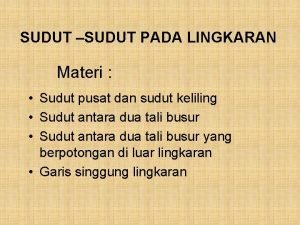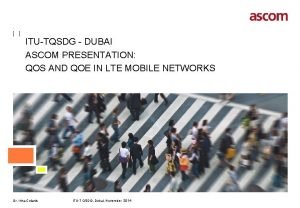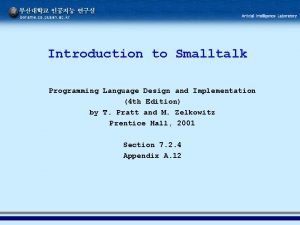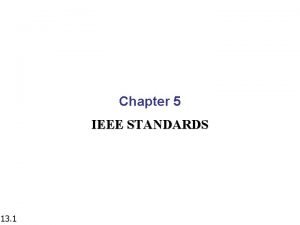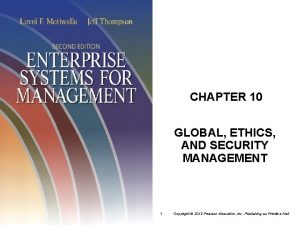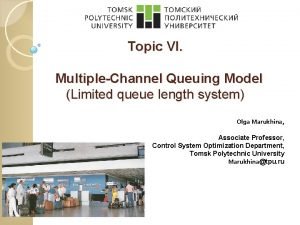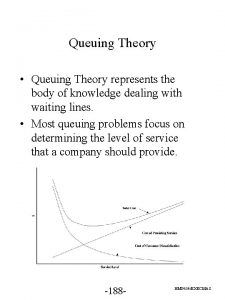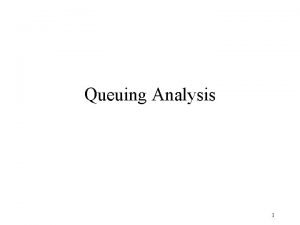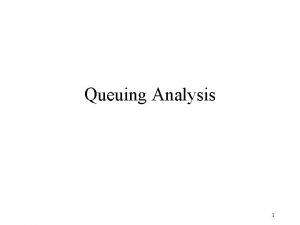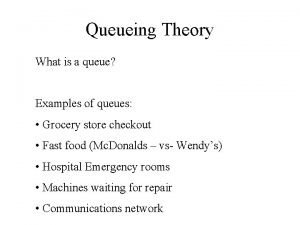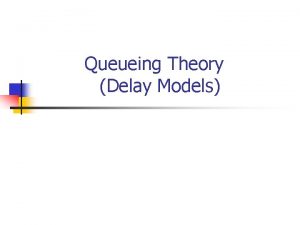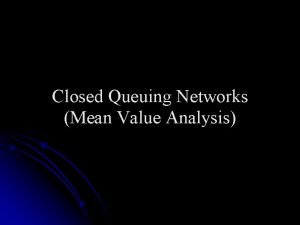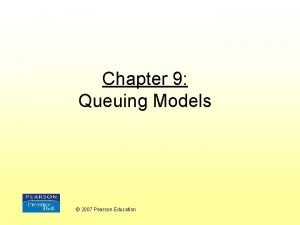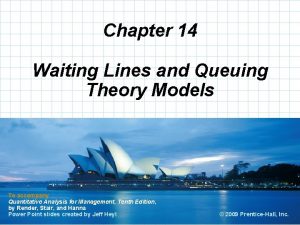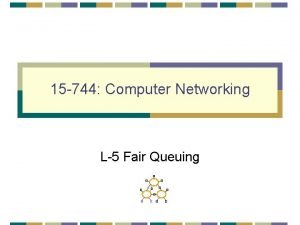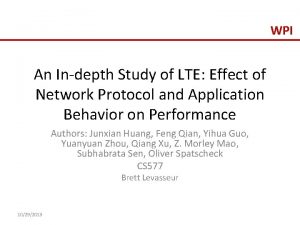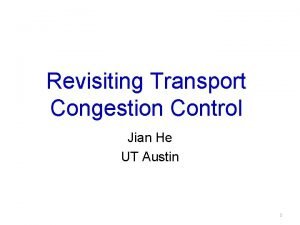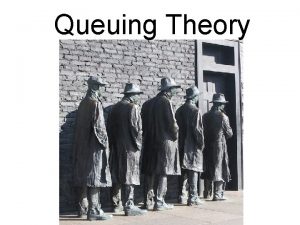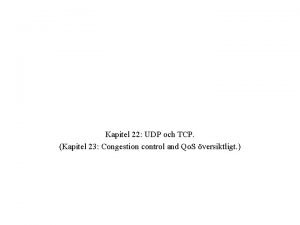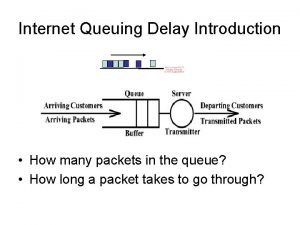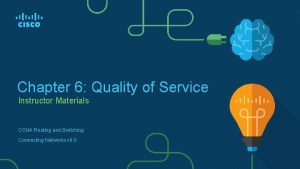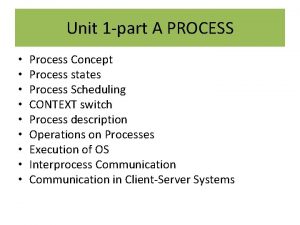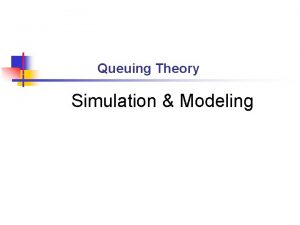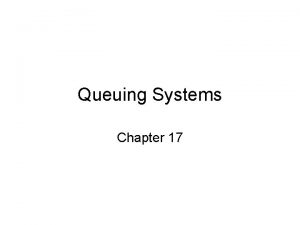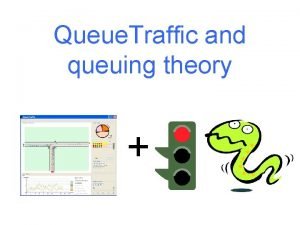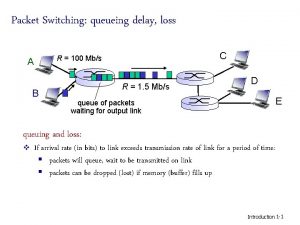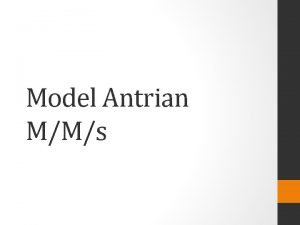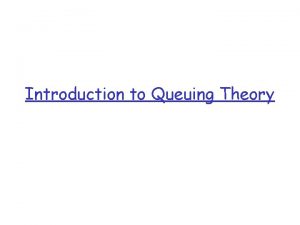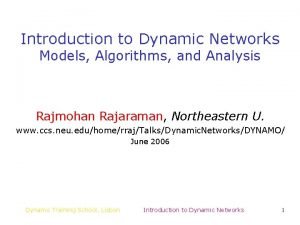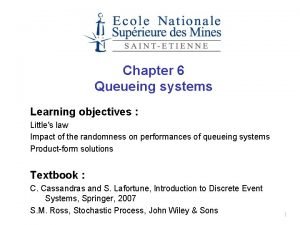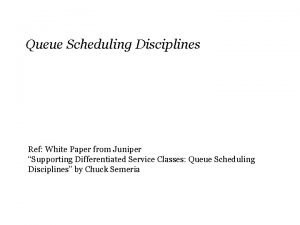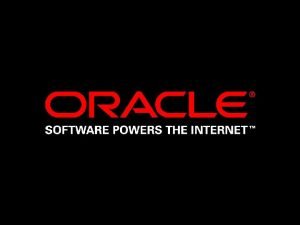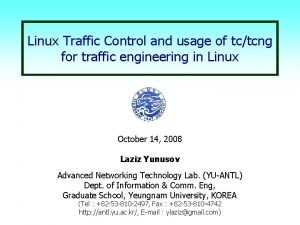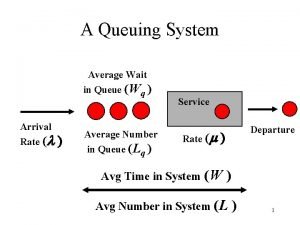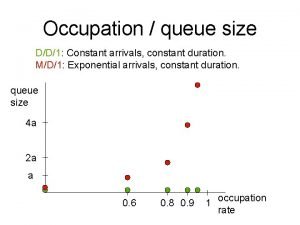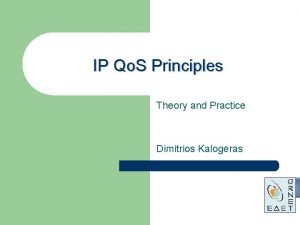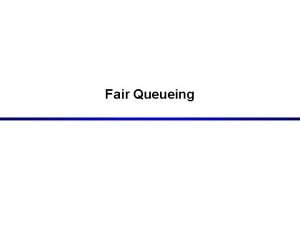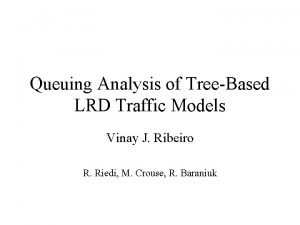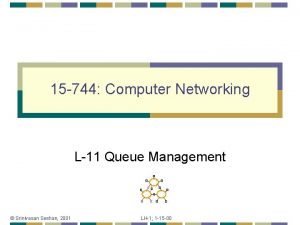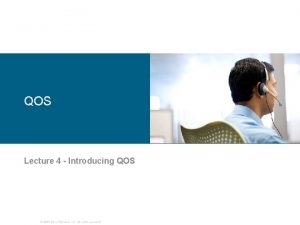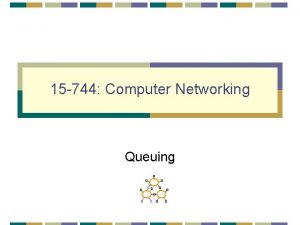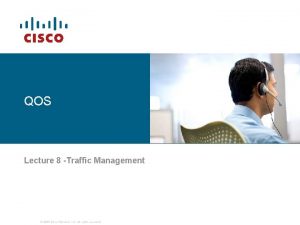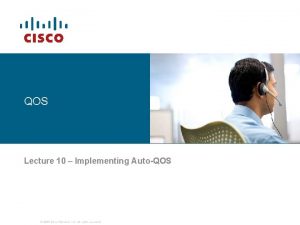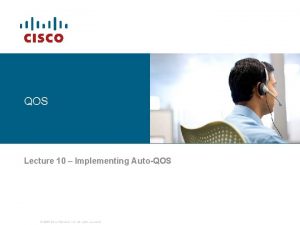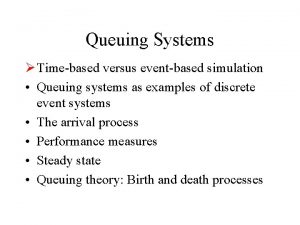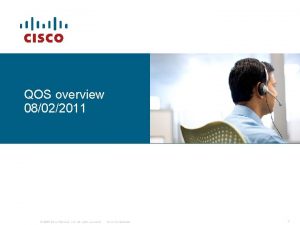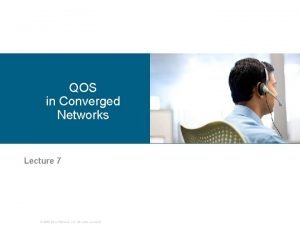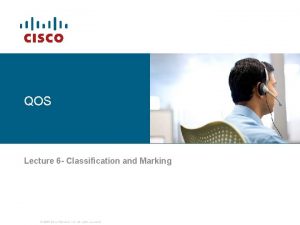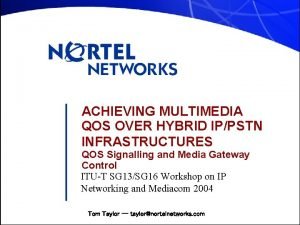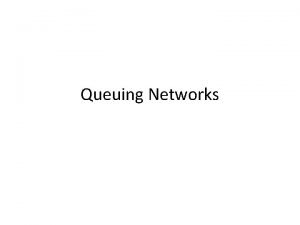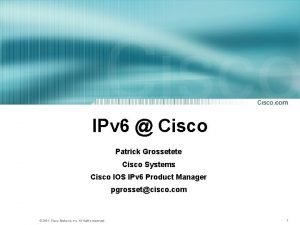QOS Lecture 7 Queuing Implementations 2006 Cisco Systems

























![Configuring WFQ router(config-if)# fair-queue [cdt [dynamic-queues [reservablequeues]]] § cdt: Number of messages allowed in Configuring WFQ router(config-if)# fair-queue [cdt [dynamic-queues [reservablequeues]]] § cdt: Number of messages allowed in](https://slidetodoc.com/presentation_image/74f5575bba6dca80f1f27a2f089a1cd6/image-26.jpg)













![Monitoring CBWFQ router> show policy-map interface [interface] • Displays parameters and statistics of CBWFQ Monitoring CBWFQ router> show policy-map interface [interface] • Displays parameters and statistics of CBWFQ](https://slidetodoc.com/presentation_image/74f5575bba6dca80f1f27a2f089a1cd6/image-40.jpg)




![Configuring LLQ router(config-pmap-c)# priority bandwidth [burst] • Allocates a fixed amount of bandwidth (in Configuring LLQ router(config-pmap-c)# priority bandwidth [burst] • Allocates a fixed amount of bandwidth (in](https://slidetodoc.com/presentation_image/74f5575bba6dca80f1f27a2f089a1cd6/image-45.jpg)


- Slides: 47

QOS Lecture 7 - Queuing Implementations © 2006 Cisco Systems, Inc. All rights reserved.

Congestion and Queuing § Congestion can occur at any point in the network where there are points of speed mismatches or aggregation. § Queuing manages congestion to provide bandwidth and delay guarantees. © 2006 Cisco Systems, Inc. All rights reserved.

Speed Mismatch • Speed mismatches are the most typical cause of congestion. • Possibly persistent when going from LAN to WAN. • Usually transient when going from LAN to LAN. © 2006 Cisco Systems, Inc. All rights reserved.

Aggregation © 2006 Cisco Systems, Inc. All rights reserved.

What is Queuing? § Queuing is a congestion-management mechanism that allows you to control congestion on interfaces. § Queuing is designed to accommodate temporary congestion on an interface of a network device by storing excess packets in buffers until bandwidth becomes available. © 2006 Cisco Systems, Inc. All rights reserved.

Congestion and Queuing . © 2006 Cisco Systems, Inc. All rights reserved.

Queuing Algorithms § First-in, first-out (FIFO) § Priority queuing (PQ) § Round robin § Weighted round robin (WRR) © 2006 Cisco Systems, Inc. All rights reserved.

FIFO § First packet in is first packet out § Simplest of all § One queue § All individual queues are FIFO © 2006 Cisco Systems, Inc. All rights reserved.

Priority Queuing § Uses multiple queues § Allows prioritization § Always empties first queue before going to the next queue: § Empty queue number 1. § If queue number 1 is empty, then dispatch one packet from queue number 2. § If both queue number 1 and queue number 2 are empty, then dispatch one packet from queue number 3. § Queues number 2 and number 3 may “starve” © 2006 Cisco Systems, Inc. All rights reserved.

Round Robin Queuing § Uses multiple queues § No prioritization § Dispatches one packet from each queue in each round: One packet from queue number 1 One packet from queue number 2 One packet from queue number 3 Then repeat © 2006 Cisco Systems, Inc. All rights reserved.

Weighted Round Robin Queuing § Allows prioritization § Assign a weight to each queue § Dispatches packets from each queue proportionately to an assigned weight: § Dispatch up to four from queue number 1. § Dispatch up to two from queue number 2. § Dispatch 1 from queue number 3. § Go back to queue number 1. © 2006 Cisco Systems, Inc. All rights reserved.

Problems with Weighted Round Robin Queuing § Problem with WRR: Some implementations of WRR dispatch a configurable number of bytes (threshold) from each queue for each round—several packets can be sent in each turn. The router is allowed to send the entire packet even if the sum of all bytes is more than the threshold. © 2006 Cisco Systems, Inc. All rights reserved.

Router Queuing Components § Each physical interface has a hardware and a software queuing system. © 2006 Cisco Systems, Inc. All rights reserved.

Hardware and Software Router Queuing Components § The hardware queuing system always uses FIFO queuing. § The software queuing system can be selected and configured depending on the platform and Cisco IOS version. © 2006 Cisco Systems, Inc. All rights reserved.

The Software Queue § Generally, a full hardware queue indicates interface congestion, and software queuing is used to manage it. § When a packet is being forwarded, the router will bypass the software queue if the hardware queue has space in it (no congestion). © 2006 Cisco Systems, Inc. All rights reserved.

The Hardware Queue § Routers determine the length of the hardware queue based on the configured bandwidth of the interface. § The length of the hardware queue can be adjusted with the txring-limit command. § Reducing the size of the hardware queue has two benefits: It reduces the maximum amount of time that packets wait in the FIFO queue before being transmitted. It accelerates the use of Qo. S in Cisco IOS software. § Improper tuning of the hardware queue may produce undesirable results: A long transmit queue may result in poor performance of the software queuing system. A short transmit queue may result in a large number of interrupts, which causes high CPU utilization and low link utilization. © 2006 Cisco Systems, Inc. All rights reserved.

Monitoring Hardware Queue Transmit Queue Length § The show controllers serial 0/1/0 command shows the length of the hardware queue. R 1#show controllers serial 0/1/0 Interface Serial 0/1/0 Hardware is GT 96 K DCE V. 11 (X. 21), clock rate 384000 <. . . part of the output omitted. . . > 1 sdma_rx_reserr, 0 sdma_tx_reserr 0 rx_bogus_pkts, rx_bogus_flag FALSE 0 sdma_tx_ur_processed tx_limited = 1(2), errata 19 count 1 - 0, count 2 - 0 Receive Ring rxr head (27)(0 x 075 BD 090), rxr tail (0)(0 x 075 BCEE 0) rmd(75 BCEE 0): nbd 75 BCEF 0 cmd_sts 80800000 buf_sz 06000000 buf_ptr 75 CB 8 E 0 rmd(75 BCEF 0): nbd 75 BCF 00 cmd_sts 80800000 buf_sz 06000000 buf_ptr 75 CCC 00 <. . . rest of the output omitted. . . > © 2006 Cisco Systems, Inc. All rights reserved.

Congestion on Software Interfaces § Subinterfaces and software interfaces (dialers, tunnels, Frame Relay subinterfaces) do not have their own separate transmit queue. § Subinterfaces and software interfaces congest when the transmit queue of their main hardware interface congests. § The tx-ring state (full, not-full) is an indication of hardware interface congestion. § The terms “Tx. Q” and “tx-ring” both describe the hardware queue and are interchangeable. © 2006 Cisco Systems, Inc. All rights reserved.

Weighted Fair Queuing (WFQ) § A queuing algorithm should share the bandwidth fairly among flows by: Reducing response time for interactive flows by scheduling them to the front of the queue Preventing high-volume flows from monopolizing an interface § In the WFQ implementation, conversations are sorted into flows and transmitted by the order of the last bit crossing its channel. § Unfairness is reinstated by introducing weight to give proportionately more bandwidth to flows with higher IP precedence (lower weight). § The terms “WFQ flows” and “conversations” can be interchanged. © 2006 Cisco Systems, Inc. All rights reserved.

WFQ Operation © 2006 Cisco Systems, Inc. All rights reserved.

WFQ Architecture § WFQ uses per-flow FIFO queues. © 2006 Cisco Systems, Inc. All rights reserved.

WFQ Classification Source Destination IP IP Address Protocol Address To. S Source Port Destination Port WFQ classification uses the following parameters: • Source IP address • Destination IP address • Transport protocol • To. S field • Source TCP or UDP port • Destination TCP or UDP port § Packets of the same flow end up in the same queue. © 2006 Cisco Systems, Inc. All rights reserved.

Implementing WFQ Classification § A fixed number of per-flow queues is configured. § A hash function is used to translate flow parameters into a queue number. § System packets (eight queues) and RSVP flows (if configured) are mapped into separate queues. § Two or more flows could map into the same queue, resulting in lower per-flow bandwidth. § Important: The number of queues configured should be significantly larger than the expected number of flows. © 2006 Cisco Systems, Inc. All rights reserved.

WFQ Insertion and Drop Policy § WFQ has two modes of dropping: Early dropping when the congestive discard threshold (CDT) is reached Aggressive dropping when the hold-queue limit is reached § WFQ always drops packets of the most aggressive flow. § Drop mechanism exceptions: A packet classified into an empty queue is never dropped. The packet IP precedence has no effect on the dropping scheme. § Queue length is determined by finish time, not size. © 2006 Cisco Systems, Inc. All rights reserved.

Benefits and Drawbacks of WFQ Benefits – Simple configuration (no need for classification to be configured) – Guarantees throughput to all flows – Drops packets of most aggressive flows – Supported on most platforms Drawbacks – Supported in most Cisco IOS versions – Possibility of multiple flows ending up in one queue – Lack of control over classification – Supported only on links less than or equal to 2 Mb – Cannot provide fixed bandwidth guarantees © 2006 Cisco Systems, Inc. All rights reserved.
![Configuring WFQ routerconfigif fairqueue cdt dynamicqueues reservablequeues cdt Number of messages allowed in Configuring WFQ router(config-if)# fair-queue [cdt [dynamic-queues [reservablequeues]]] § cdt: Number of messages allowed in](https://slidetodoc.com/presentation_image/74f5575bba6dca80f1f27a2f089a1cd6/image-26.jpg)
Configuring WFQ router(config-if)# fair-queue [cdt [dynamic-queues [reservablequeues]]] § cdt: Number of messages allowed in each queue (a new threshold must be a power of 2 in the range from 16 to 4096; default is 64). When a conversation reaches this threshold, new message packets are discarded. § dynamic-queues: Number of dynamic queues used for best-effort conversations (values are: 16, 32, 64, 128, 256, 512, 1024, 2048, and 4096; the default is 256). § reservable-queues: Number of reservable queues used for reserved conversations in the range 0 to 1000 (used for interfaces configured for features such as RSVP—the default is 0). © 2006 Cisco Systems, Inc. All rights reserved.

WFQ Maximum Limit Configuration router(config-if)# hold-queue max-limit out § Specifies the maximum number of packets that can be in all output queues on the interface at any time. § The default value for WFQ is 1. § Under special circumstances, WFQ can consume a lot of buffers, which may require lowering this limit. © 2006 Cisco Systems, Inc. All rights reserved.

Monitoring WFQ router> show interface • Displays interface delays including the activated queuing mechanism with the summary information Router>show interface serial 1/0 Hardware is M 4 T Internet address is 20. 0. 0. 1/8 MTU 1500 bytes, BW 19 Kbit, DLY 20000 usec, rely 255/255, load 147/255 Encapsulation HDLC, crc 16, loopback not set Keepalive set (10 sec) Last input 00: 00: 00, output hang never Last clearing of "show interface" counters never Input queue: 0/75/0 (size/max/drops); Total output drops: 0 Queueing strategy: weighted fair Output queue: 0/1000/64/0 (size/max total/threshold/drops) Conversations 0/4/256 (active/max total) Reserved Conversations 0/0 (allocated/max allocated) 5 minute input rate 18000 bits/sec, 8 packets/sec 5 minute output rate 11000 bits/sec, 9 packets/sec © 2006 Cisco Systems, Inc. All rights reserved.

Monitoring WFQ Interface router> show queue interface-name interface-number • Displays detailed information about the WFQ system of the selected interface Router>show queue serial 1/0 Input queue: 0/75/0 (size/max/drops); Total output drops: 0 Queueing strategy: weighted fair Output queue: 2/1000/64/0 (size/max total/threshold/drops) Conversations 2/4/256 (active/max total) Reserved Conversations 0/0 (allocated/max allocated) (depth/weight/discards/tail drops/interleaves) 1/4096/0/0/0 Conversation 124, linktype: ip, length: 580 source: 193. 77. 3. 244, destination: 20. 0. 0. 2, id: 0 x 0166, ttl: 254, TOS: 0 prot: 6, source port 23, destination port 11033 (depth/weight/discards/tail drops/interleaves) 1/4096/0/0/0 Conversation 127, linktype: ip, length: 585 source: 193. 77. 4. 111 destination: 40. 0. 0. 2, id: 0 x 020 D, ttl: 252, TOS: 0 prot: 6, source port 23, destination port 11013 © 2006 Cisco Systems, Inc. All rights reserved.

Combining Queuing Methods § Basic methods are combined to create more versatile queuing mechanisms. © 2006 Cisco Systems, Inc. All rights reserved.

Class-Based Weighted Fair Queuing § CBWFQ is a mechanism that is used to guarantee bandwidth to classes. § CBWFQ extends the standard WFQ functionality to provide support for user-defined traffic classes: Classes are based on user-defined match criteria. Packets satisfying the match criteria for a class constitute the traffic for that class. § A queue is reserved for each class, and traffic belonging to a class is directed to that class queue. © 2006 Cisco Systems, Inc. All rights reserved.

CBWFQ Architecture © 2006 Cisco Systems, Inc. All rights reserved.

CBWFQ Classification § Classification uses class maps. § Availability of certain classification options depends on the Cisco IOS version. § Some classification options depend on type of interface and encapsulation where service policy is used. § For example: Matching on Frame Relay discard-eligible bits can be used only on interfaces with Frame Relay encapsulation. Matching on MPLS experimental bits has no effect if MPLS is not enabled. Matching on ISL priority bits has no effect if ISL is not used. © 2006 Cisco Systems, Inc. All rights reserved.

CBWFQ Scheduling Mechanisms § CBWFQ guarantees bandwidth according to weights assigned to traffic classes. § Weights are internally calculated from bandwidth or its percentage. § Bandwidth availability can be defined by specifying: Bandwidth (in kbps) Percentage of bandwidth (percentage of available interface bandwidth) Percentage of remaining available bandwidth § One service policy cannot have mixed types of weights. § The show interface command can be used to display the available bandwidth. © 2006 Cisco Systems, Inc. All rights reserved.

Available Bandwidth § Available bandwidth is calculated according to the following formula: By default, 75 percent of the interface bandwidth can be used by CBWFQ and LLQ. To specify a specific amount of bandwidth to be allocated, the Max. Reservable variable can be changed using the max-reservedbandwidth command. © 2006 Cisco Systems, Inc. All rights reserved.

CBWFQ Benefits and Drawbacks Benefits – Custom-defined classifications – Minimum bandwidth allocation – Finer granularity and scalability Drawback – Voice traffic can still suffer unacceptable delay © 2006 Cisco Systems, Inc. All rights reserved.

Configuring CBWFQ router(config-pmap-c)# bandwidth • Allocates a fixed amount of bandwidth to a class • Sets the value in kilobits per second router(config-pmap-c)# bandwidth percent • Allocates a percentage of bandwidth to a class • The configured (or default) interface bandwidth is used to calculate the guaranteed bandwidth router(config-pmap-c)# bandwidth remaining percent • Allocates a percentage of available bandwidth to a class © 2006 Cisco Systems, Inc. All rights reserved.

Configuring CBWFQ (Cont. ) router(config-pmap-c)# queue-limit • Sets the maximum number of packets that this queue can hold. • The default maximum is 64. router(config-pmap-c)# fair-queue [number-of-dynamic-queues] • The class-default class can be configured to use WFQ. • The number of dynamic queues is a power of 2 in the range from 16 to 4096, specifying the number of dynamic queues. © 2006 Cisco Systems, Inc. All rights reserved.

Example CBWFQ Configuration Router(config)#access-list 101 permit udp host 10. 10. 10 host 10. 10. 20 range 16384 20000 Router(config-if)#access-list 102 permit udp host 10. 10. 10 host 10. 10. 20 range 53000 56000 Router(config)#class-map class 1 Router(config-cmap)#match access-group 101 Router(config-cmap)#exit Router(config)#class-map class 2 Router(config-cmap)#match access-group 102 Router(config-cmap)#exit Router(config)#policy-map policy 1 Router(config-pmap)#class 1 Router(config-pmap-c)#bandwidth 3000 Router(config-pmap-c)#queue-limit 30 Router(config-pmap-c)#exit Router(config-pmap)#class 2 Router(config-pmap-c)#bandwidth 2000 Router(config-pmap-c)#exit Router(config-pmap)#class-default Router(config-pmap-c)#fair-queue Router(config-pmap-c)#exit © 2006 Cisco Systems, Inc. All rights reserved.
![Monitoring CBWFQ router show policymap interface interface Displays parameters and statistics of CBWFQ Monitoring CBWFQ router> show policy-map interface [interface] • Displays parameters and statistics of CBWFQ](https://slidetodoc.com/presentation_image/74f5575bba6dca80f1f27a2f089a1cd6/image-40.jpg)
Monitoring CBWFQ router> show policy-map interface [interface] • Displays parameters and statistics of CBWFQ Router#show policy-map interface Fast. Ethernet 0/0 Service-policy output: policy 1 Class-map: class 1 (match-all) 0 packets, 0 bytes 5 minute offered rate 0 bps, drop rate 0 bps Match: access-group 101 Queueing Output Queue: Conversation 265 Bandwidth 3000 (kbps) Max Threshold 30 (packets) (pkts matched/bytes matched) 0/0 (depth/total drops/no-buffer drops) 0/0/0 <. . . part of the output omitted. . . > Class-map: class-default (match-any) 0 packets, 0 bytes 5 minute offered rate 0 bps, drop rate 0 bps Match: any Queueing Flow Based Fair Queueing <. . . rest of the output omitted. . . > © 2006 Cisco Systems, Inc. All rights reserved.

Low Latency Queuing (LLQ) § A priority queue is added to CBWFQ for real-time traffic. § High-priority classes are guaranteed: Low-latency propagation of packets Bandwidth § High-priority classes are also policed when congestion occurs—they then cannot exceed their guaranteed bandwidth. § Lower-priority classes use CBWFQ. © 2006 Cisco Systems, Inc. All rights reserved.

LLQ Architecture © 2006 Cisco Systems, Inc. All rights reserved.

LLQ Benefits § High-priority classes are guaranteed: Low-latency propagation of packets Bandwidth § Configuration and operation are consistent across all media types. § Entrance criteria to a class can be defined by an ACL: Not limited to UDP ports as with IP RTP priority Defines trust boundary to ensure simple classification and entry to a queue © 2006 Cisco Systems, Inc. All rights reserved.

Metering § Traffic is metered when congestion occurs § Priority traffic metering: Only during conditions of congestion Performed on a per-packet basis Restrains priority traffic to allocated bandwidth § Classes are policed and rate-limited individually. © 2006 Cisco Systems, Inc. All rights reserved.
![Configuring LLQ routerconfigpmapc priority bandwidth burst Allocates a fixed amount of bandwidth in Configuring LLQ router(config-pmap-c)# priority bandwidth [burst] • Allocates a fixed amount of bandwidth (in](https://slidetodoc.com/presentation_image/74f5575bba6dca80f1f27a2f089a1cd6/image-45.jpg)
Configuring LLQ router(config-pmap-c)# priority bandwidth [burst] • Allocates a fixed amount of bandwidth (in kilobits per second) to a class and ensures expedited forwarding. • Traffic exceeding the specified bandwidth is dropped if congestion exists; otherwise, policing is not used. router(config-pmap-c)# priority percentage [burst] • Allocates a percentage of configured or default interface bandwidth to a class and ensures expedited forwarding. • Traffic exceeding the specified bandwidth is dropped if congestion exists. © 2006 Cisco Systems, Inc. All rights reserved.

Configuring LLQ (Cont. ) class-map voip match ip precedence 5 ! class-map mission-critical match ip precedence 3 4 ! class-map transactional match ip precedence 1 2 ! policy-map Policy 1 class voip priority percent 10 class mission-critical bandwidth percent 30 class transactional bandwidth percent 20 class-default fair-queue © 2006 Cisco Systems, Inc. All rights reserved.

Monitoring LLQ router> show policy-map interface • Displays the packet statistics of all classes that are configured for all service policies on the specified interface or subinterface router>show policy-map interface fastethernet 0/0 Fast. Ethernet 0/0 Service-policy output: LLQ Class-map: LLQ (match-any) 0 packets, 0 bytes 5 minute offered rate 0 bps, drop rate 0 bps Match: any Weighted Fair Queueing Strict Priority Output Queue: Conversation 264 Bandwidth 1000 (kbps) Burst 25000 (Bytes) (pkts matched/bytes matched) 0/0 (total drops/bytes drops) 0/0 Class-map: class-default (match-any) 0 packets, 0 bytes 5 minute offered rate 0 bps, drop rate 0 bps Match: any © 2006 Cisco Systems, Inc. All rights reserved.
 Tali busur
Tali busur Volte qos
Volte qos Perbedaan qos dan qoe
Perbedaan qos dan qoe Smalltalk print
Smalltalk print Common standard ethernet implementations
Common standard ethernet implementations With erp implementations why would an auditorget involved
With erp implementations why would an auditorget involved 01:640:244 lecture notes - lecture 15: plat, idah, farad
01:640:244 lecture notes - lecture 15: plat, idah, farad Multi channel queuing model
Multi channel queuing model Queueing theory
Queueing theory Queue waiting time
Queue waiting time Queuing analysis examples
Queuing analysis examples Queuing theory formula
Queuing theory formula Queueing theory
Queueing theory Mm1 queue
Mm1 queue Closed queuing network
Closed queuing network Queuing models
Queuing models Waiting cost queuing theory
Waiting cost queuing theory Fair queuing example
Fair queuing example Queuing delay
Queuing delay Queuing delay
Queuing delay Queuing theory calculator
Queuing theory calculator Udp 23
Udp 23 Queuing delay
Queuing delay Queuing delay
Queuing delay Fair queuing
Fair queuing What is process concept
What is process concept Waiting line solution
Waiting line solution Queuing theory simulation
Queuing theory simulation Components of queuing system
Components of queuing system Queuing theory
Queuing theory Four sources of packet delay
Four sources of packet delay Mms queuing model
Mms queuing model Queuing theory definition
Queuing theory definition Queuing theory
Queuing theory Cucm native call queuing
Cucm native call queuing Little's formula queueing theory
Little's formula queueing theory Priority queuing
Priority queuing Oracle advanced queuing
Oracle advanced queuing Priority queuing
Priority queuing Priority queuing
Priority queuing Queuing process
Queuing process Dd1 queuing
Dd1 queuing Random early drop
Random early drop Wfq example
Wfq example Lrd model
Lrd model Srinivasan seshan
Srinivasan seshan Operating systems lecture notes
Operating systems lecture notes Articulators
Articulators
